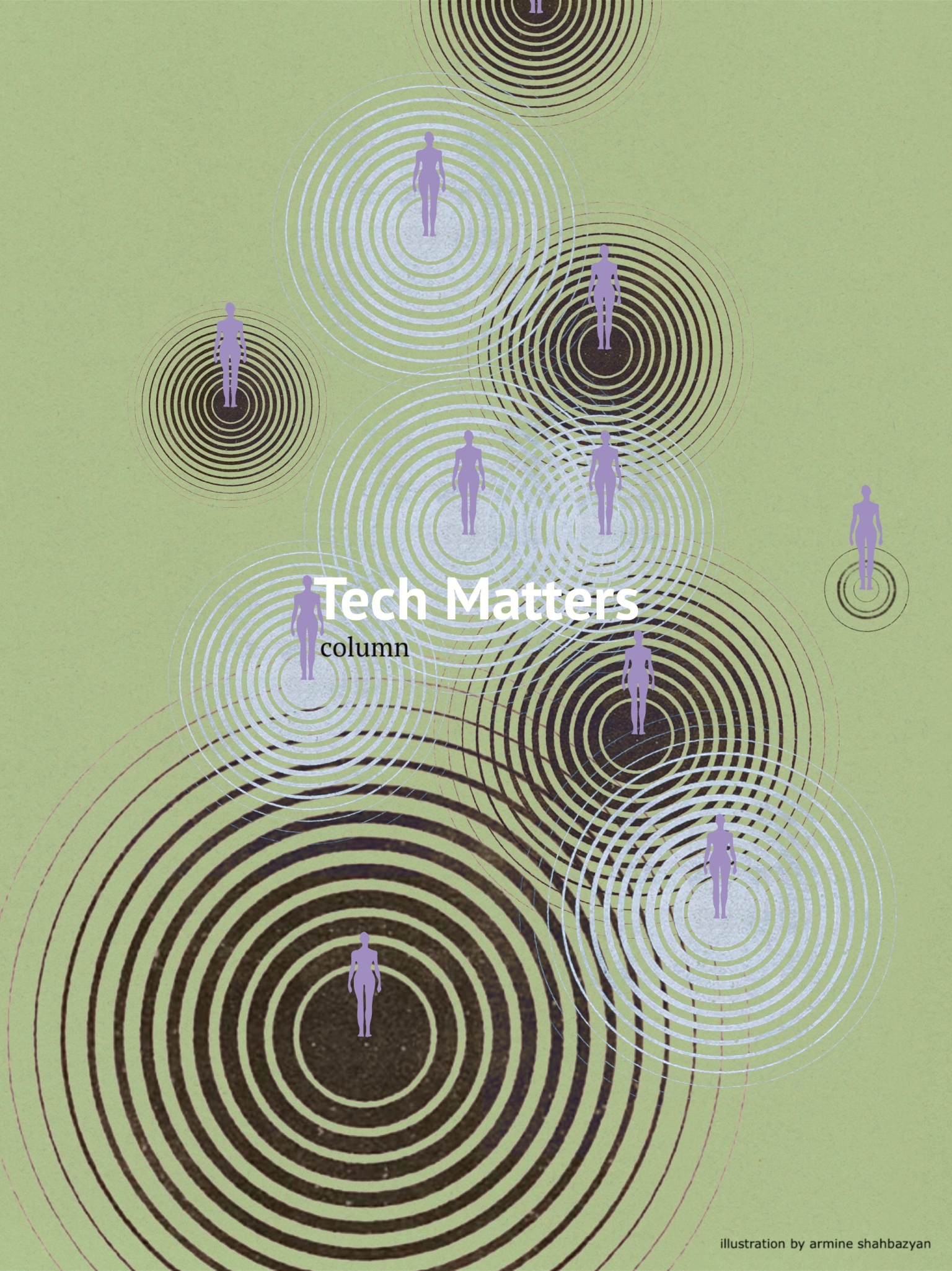
Why Tech Matters
The idea behind this column is simple: while we often reference the incredible global asset that the Diaspora is for Armenia, we have yet to find a formula for the systemic engagement of this asset for Armenia’s development. Yes, there are ample individual examples of diaspora-Armenia cooperation leading to significant progress forward for the country, but no structured, concentrated and coordinated effort to put into play the full force of the diasporan network across sectors of Armenia’s economy. Over the next few months, we will explore not only successful examples of this cooperation, but highlight areas where a similar approach will lead to outsize benefits.

Raffi Kassarjian is CEO and Principal Advisor at Sensyan, a boutique advisory firm focused on the growing Armenian tech sector. Since moving to Armenia in 2008, Raffi has led the following organizations as CEO: iCON Communications (pioneer wireless internet service provider), TeamViewer Armenia (also serving as Senior Vice President at TeamViewer GmbH), and the Union of Advanced Technology Enterprises (UATE). He was also a member of the Management Board of Converse Bank Corporation. Previously, Raffi was Vice President and General Manager at Fair Isaac Corporation (NYSE: FICO). Prior to Fair Isaac, he was a Senior Manager with Accenture’s Strategic Services practice.
Raffi is an adjunct lecturer at the American University of Armenia, and founding board member of Repat Armenia Foundation, Impact Hub Yerevan, and EVN Report.
Also see
Listen to the article.
In analyzing the supremacy of Silicon Valley as the center of innovation for technology for over half a century, most observers agree that the region’s amalgam of talent, capital and culture continue to give it an edge in spawning, growing (and yes, killing) more successful tech startups than almost anywhere else in the world. Of course, there are other hubs such as the greater Boston area for life sciences, Austin (SaaS, hardware, cybersecurity, EVs), Berlin (Fintech, blockchain, transport) and Shenzhen (consumer electronics/hardware, telecommunications, robotics, EV battery tech), but the Valley continues to be perceived as the global epicenter of technological innovation and entrepreneurship. What is so special about Silicon Valley, and what lessons can be applied to boosting the growth and relevance of Armenia’s tech scene? It turns out that it’s mostly focused on “software”—a combination of talent, capital and culture.
Talent
Silicon Valley has been able to attract top tech talent across the career lifecycle, starting with university students (Stanford, Berkeley, San Jose State), recent graduates and mid-career execs drawn by the myriad opportunities offered by start-ups and the Magnificent Seven tech companies, and thousands of career-oriented immigrants from around the world. The resulting virtuous circle of companies attracting talent, and talent available for hire fuels the continuing growth of both new ventures and established companies. In other words, even in highly competitive tech cycles, the availability of local, highly experienced and mobile talent removes one of the key barriers to growth facing other would-be tech hubs.
Capital
Countless generations of entrepreneurs have run the gauntlet of pitching the world’s top venture capitalists lined up along Sand Hill Road in Menlo Park, now extended to the corridor between Palo Alto and San Francisco. While the number of venture firms has exploded globally over the past two decades, the top-tier firms are all still clustered in the heart of Silicon Valley. This concentration is not limited to access to capital itself—top-tier VCs provide access to a wide network of equally-qualified professionals, including attorneys, bankers, consultants, technical advisors, and other entrepreneurs—in other words, start-ups in the Valley live at the center of a vertically-integrated value chain and ecosystem.
Culture
Much has been written about the “fail fast, learn, adapt and launch again” culture pervasive throughout the Valley. The presence of the Magnificent Seven, dozens of unicorns, and steady flow of newly-launched and scaling startups means that tech (and business talent) can afford to take risks on new ventures, since the “safety net” of constant hiring by this ever-evolving pool of companies, as well as VCs willing to fund new ventures by experienced entrepreneurs, is always there to catch them after a failed venture. Another, equally important feature of living and working in the Valley is that talent is always rubbing elbows with peers, existing and potential customers, and investors at meet-ups and conferences, not to mention at the countless micro-breweries, restaurants, cafes, yoga studios and gyms frequented by Valley tech residents. This concentrated network, akin to a neural network firing millions of connected synapses every day, fuels new venture formation and the building blocks of incremental and game-changing innovation.
Compete, Replicate or Forge an Independent Path?
If even the aforementioned global tech hubs can’t compete at the level of Silicon Valley, what hope is there for smaller, remote ecosystems such as Armenia’s? The answer lies in playing to strengths, and looking for opportunity vectors left open by hyper-competition between larger players.
Armenia-based, Armenia-focused Talent
For example, the resurgence of focus on and investment in semiconductor design and manufacturing plays to one of Armenian tech’s key strengths, as top global players in this field have significant R&D operations in Armenia: AMD, Nvidia, Siemens and Synopsys. As a result, Yerevan boasts one of the few concentrations of highly-experienced talent in the field, and certainly the largest on a per capita basis. While this sector itself requires significant scale and investment, talent and capital can and should flow toward rapidly-growing adjacent areas such as FPGAs, embedded systems and devices at the intersection of hardware and software. In other words, entrepreneurs looking to rapidly launch and spin up start-ups in this space can find high concentrations of qualified talent at highly-competitive rates in the Armenian ecosystem.
Global competition in AI is even more intense and requires a depth of talent hard to find in Armenia. However, bright spots exist, and should be exploited: AI-driven computer vision, audio processing, new drug discovery and molecule modeling, in addition to data management for large-scale AI projects, are a few such examples. Moreover, the small but influential group of Armenian AI experts dispersed throughout companies in Germany, South Korea and the U.S. can play a key role in mentoring and developing talent in Armenia—many are already doing so. Finally, growing investment in degree programs and R&D labs at Armenian higher education institutions by private companies can accelerate the development of talent.
While tech talent can be grown anywhere with a strong education system, the complementary skill sets required to launch and grow successful global tech ventures—sales, business development, marketing, customer support, product and executive management—usually abundant in developed ecosystems such as Silicon Valley, are scarce in markets like Armenia. Home-growing this type of talent is challenging because unlike engineering, these “softer” skills are better developed via experience rather than taught in classrooms, and experience requires a globally-connected local market for skills to develop. As such, it’s critical to expose Armenian founders and developing talent to seasoned executives from the Valley and beyond. As covered in an earlier column, this takes place at an individual/organic level, but must be elevated to a strategic, systemic approach to have real effect.
Growing Availability of Capital
Locally-accessible angel and venture capital is on the rise, removing one of the most debilitating challenges Armenian entrepreneurs faced a few years ago. While still limited to pre-seed and seed rounds, the ability to raise seven-digit rounds locally has given start-ups the critical early runway they need to then seek growth-stage capital abroad, and it’s fair to assume that more Series A financing will be available locally in the coming years.
Blending Cultures
The growing Armenian start-up scene has produced a number of local and repatriated entrepreneurs who are now “giving back” via mentorship, meet-ups, podcasts and other forms of sharing their experience with the next generation of start-up founders. Until recently, the disbalance between demand for tech professionals and available talent meant that just as in Silicon Valley, budding entrepreneurs were willing to plunge into the risky world of new ventures, knowing that, if things didn’t work out, they could always find a position in one of the more established companies thirsty for talent. However, despite a growing tech sector (latest official figures for 2024 suggest that there are more than 50,000 people employed in tech in Armenia), we are nowhere near the depth, breadth and quality of talent concentrated between San Francisco and San Jose. Start-up founders with experience in the Valley, as well as more established companies, have worked to introduce Western/Valley working culture to their Armenian teams, but there is much more to do to elevate the effectiveness of the tech work culture in Yerevan and beyond. Again, creating a systemic approach for local talent to rub elbows with peers in Silicon Valley and beyond is key; Armenia must double down on events such as WCIT, Digitec, HIVE Venture Summits, and Silicon Mountains to expose local tech industry talent to the global pool. At the same time, the Armenian government should expand its policies to allow tech companies to receive tax credits for training and education of their employees to cover the costs of sending employees to international conferences and seminars, one of the best ways to expose them to the leading/bleeding edge of technological innovation.
Looking Ahead
As a small country with large ambitions, Armenia must intensify investment in the “software” of innovation: talent, capital and culture. While large-scale investments in infrastructure such as world-class laboratories, research institutes and university facilities are key, collectively, these are ultimately investments in people, and that’s where the focus should be.




